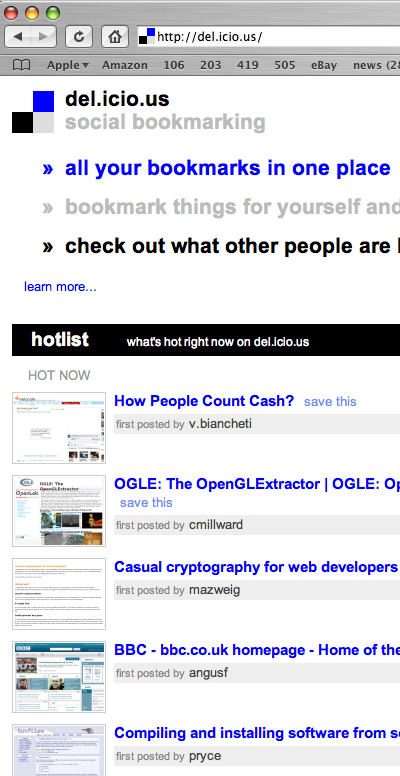
Olly Olly Oxen Free (Tags Are It)
This review focuses on del.icio.us, a free social bookmarking site and one of the cornerstones of Web 2.0. For those unfamiliar with social bookmarking, imagine the "favorite" function of Internet Explorer or the "bookmark" function of Firefox or Safari: a method of marking, categorizing, and retrieving important URLs. del.icio.us offers a number of improvements over these browser-based cataloguing tools- first and foremost that your selections are posted online and are thus accessible from anywhere, not just from your personal computer. Furthermore, del.icio.us allows everyone to see everyone else's bookmarks and even aggregates that data to produce a human-powered search engine to compliment algorithmic engines such as Google or Zuula. And the del.icio.us homepage, which displays the 13 "hottest" (most actively saved) sites, is an addiction all to itself.
Beyond these benefits, the most significant advantage of del.icio.us is its method of cataloging entries: tagging. del.icio.us defines tags as:
...one-word descriptors that you can assign to your bookmarks on del.icio.us. They're a little bit like keywords but non-hierarchical. You can assign as many tags to a bookmark as you like and easily rename or delete them later. Tagging can be a lot easier and more flexible than fitting your information into preconceived categories or folders.
Tagging does not seek to replicate a physical organization system for information; there are no "files" being placed in "folders." In The Long Tail, Chris Anderson points out the ontological/categorical/strict-taxonomic organization of systems such as the Dewey decimal system, are effective organizational strategies for physical objects, but fail to capitalize on the unique, non-physical properties of digital information (156-159). Such top-down, hierarchical systems are designed to properly "place" physical objects. Tagging represents a mode of organization that can only be realized once information becomes digital and is thus no longer tied to the limitations of physical place. Tagged data has no singular proper place- users in folksonomies such as del.icio.us can simultaneously tag data in multiple ways, allowing it to exist across any number of spaces. Rather than attempting to organize information according to pre-existing, structured categories, Anderson imagines
a world of ad-hoc organization, determined by whatever makes sense at the time. That's more like a big pile of stuff on a desk instead of rows of items stringently arranged on shelves. Sure it may seem messy, but that's just because it's a different kind of organization: spontaneous, contextual order, easily reordered into a different context as need be. (159)
Thinking of del.icio.us, we can add "idiosyncracy" to Anderson's description of tagging as a mode of organization. Each del.icio.us user is likely to tag pages differently. Such a random system might not be as "neat" as the Dewey decimal system, but its flexibility and fluidity allow it to effectively capture what Suriowecki and others refer to as "the wisdom of crowds." To overstate the theoretical implications: del.icio.us can be seen as a collective attempt to explore, organize, and share the web underwritten by a spirit of enthusiasm and generosity ("Look what I found!") rather than one of mastery or colonization ("We must order this"). While an extended discussion of the impact of tagging and digitality is beyond my scope here, those interested should see Dave Weinberger's insightful Everything is Miscellaneous which ambitiously approaches a new metaphysics for digital information (see especially pages 92-95 for how del.icio.us and tagging contribute to this effort; see also his webtext "The Hyperlinked Metaphysics of the Web"). Interested parties should also give Clay Shirky's seminal "Ontology is Overrated: Categories, Links, and Tags" some attention.
In addition to tagging, del.icio.us allows for easy syndication, exportation, and publication of links. Users can track the postings of other users or even of a specific tag. These properties taken together: accessibility, flexibility, and transportability, make for a powerful pedagogical resource. The next section of this article is intended for those completely new to del.icio.us; it provides a walkthrough for creating an account, uploading the all-powerful browser buttons, and familiarizing potential acolytes with the posting process. Those already familiar with del.icio.us might want to skip ahead to pedagogical possibilities.
The review goes on to provide a few pedagogical possibilities for del.icio.us. It also points toward a few frustrations that del.icio.us can produce. In short, while del.icio.us might suffer a bit as a research tool, it offers a powerful collaborative tool for generating and extending class discussion and cooperation. And we all know the Web 2.0 mantra: Sharing is good.
Up next: Getting Started.